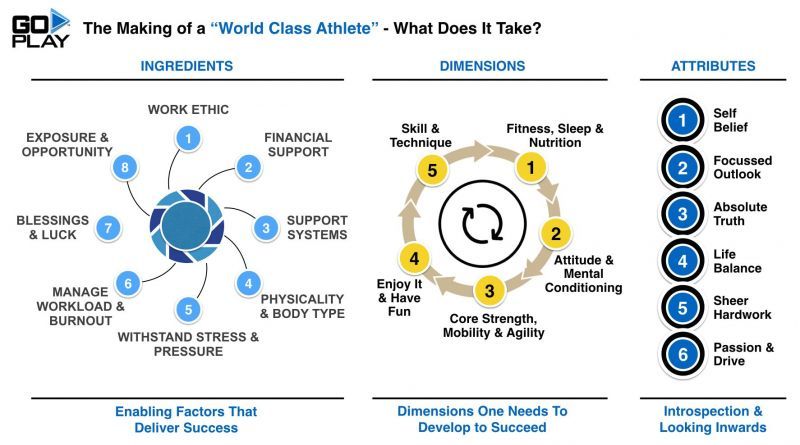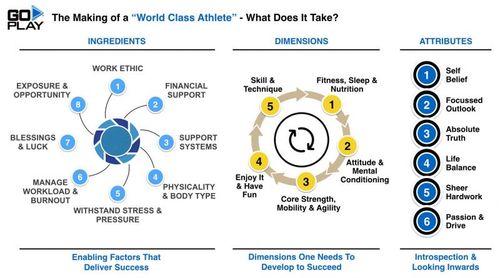
The Making of a World Class Athlete
The most widely acknowledged rule is Sports is that it takes 10, 000 hours of practice to excel and master any discipline and emerge ahead of the field. At least, this is what a 1993 paper written by Anders Ericsson, a Professor at the University of Colorado, called The Role of Deliberate Practice in the Acquisition of Expert Performance. While a repetitive practice may fine-tune skill & technique and hone it to exceptional levels, there are many other elements one needs to refine and master to emerge ahead of the game and compete and sustain oneself at world standards.
Across world sport, there are athletes that stand apart from their peers on account of certain exceptional abilities they possess. These special abilities are way beyond the ordinary. For example, Roger Federer's ability to ruthlessly dominate world tennis for over a decade and then reinvent his game to win 3 Grand Slam titles in his mid 30's. Or Virat Kohli's application, effort and commitment to continuously raise the performance bar and deliver 2,818 runs in 2017 across formats (11 Hundreds including 3 Doubles & 10 Fifties at an average of over 70). Or Jahangir Khan's, discipline, hard work, fitness and ambition that enabled him to remain unbeaten in World Squash for over 5 years and win a record 555 matches consecutively. Or Usain Bolt's domination of world athletics through his unrelenting focus and immense self-belief that won him a record 9 Olympic Golds. Or Lionel Messi's ability to read the game, his patience & his ability to repeatedly score under pressure making him one of the greatest footballers in history.
Having spoken to athletes from different disciplines, age groups, geographies, gender and across generations, three critical elements emerge that create the difference between extraordinary and spectacular performance:

ELEMENT (01): INGREDIENTS
Eight ingredients (in no order of priority or importance) go into a world-class athlete recipe. These are enabling baseline factors that deliver success and includes:
#1: Work Ethic - the willingness and discipline to put in thousands of hours of structured practice & repetitive game drills simulating match situations helps an athlete develop the right mental orientation to deal with situations in match play. This then defines the ability of the athlete to focus and create winning moments.
#2: Financial Support - Sports training is a costly affair. Unless the athlete has the financial means to support his interest in a sport, moving forward becomes very difficult. Financial support from family and community in the early years propels the interest into a passion.
#3: Support Systems - The family enables the athlete to explore his interest in the sport by managing the mundane such as logistics of travel, food, scheduling, academic priorities & competitions. The occasional family encouragement, a kind word, the nudge to push forward and the cheering goes a long way to propel the athlete forward. But most importantly, the family has to manage and monitor the athlete from a distance. Otherwise, boundaries get blurred which leads to friction and trouble.
#4: Physicality & Body Type - A lean physique, hand and eye coordination, nimbleness, flexibility and quick reflexes are the first signs in an individual with a natural orientation to a sport. In addition, the desire to be out doors, enjoy breaking a sweat, the willingness to compete and to extend beyond our limits are other first signs.
#5: Withstand Stress & Pressure - In the early years of an budding athlete's life, the pressure to excel at academics, participate in school activities while exploring an interest in sport becomes challenging for most individuals. In addition, the overbearing or subtle pressure exerted by friends, family and the community to deliver results in sports becomes too much for most individuals to handle. The ones who deal with it, move forward in competitive sport and discover this to be a life skill & a key differentiator.
#6: Manage Workload & Burnout - The balance between fitness, training and rest is critical to establish early in an athlete's life. Too much time in training does not allow the athlete time to physically and emotionally recover and recuperate. In addition, over-enthusiastic family members constantly talking sports in the off time leads to more damage. Rest, other recreational pursuits and downtime are critical for long-term success
#7: Blessings & Luck - Simply put, one needs to be blessed. Luck plays a big role in sports. Having trained for extended periods of time with a singular purpose, sometimes the luck of the draw, a bad referee decision, a broken string on a crucial point, playing against a crowd favorite or just a bad day can make the difference between winning and losing. Of course, the athlete learns to cope with the unexpected over time. But sometimes winning requires the athlete's stars to be perfectly aligned plus the mother's blessings in order to cross the finish line, as intended. That's sport.
#8: Exposure & Opportunity - The opportunity to compete in different tournaments, other geographies, against different athletes in different match play conditions provides phenomenal exposure to the athlete to test himself. In such testing situations, he discovers himself and evolves for the better. In other situations, the shock pushes the athlete to introspect and then work harder to improve.
ELEMENT (02): DIMENSIONS
Five dimensions (in no order of priority or importance) that need to develop in order to compete and succeed at the highest level of play in any sport and includes:
#1: Fitness, Sleep & Nutrition - What you eat, your hydration levels, how you train and how much you rest your mind and your body fundamentally defines the outcomes you want to attain as an athlete. If you are well fed and well rested and then enter the playing arena, you will be bursting with energy and the desire to give the best account of yourself.
#2: Attitude & Mental Conditioning - Attitude is a sum total of an athletes level of long-term goals, individual ownership, process adherence, appetite for challenge & risk-taking ability. Bad attitude leads to poor preparation, sub-optimal execution and delivers disappointing results. Positive thinking, game and outcome visualization, scenario planning, mental & physical drills to deal with competitive pressure & breathing exercises are some of the tools used to prepare, perform and deliver results.
#3: Core Strength, Mobility & Agility - Its quite unfortunate that most athletes pay the least attention to this fundamental dimension. Core strength protects you from injury, protects your central nervous system, improves body balance and allows endurance. Mobility is an indication of how well and efficiently we move and is key to avoiding injuries. Agility helps the body efficiently orchestrate integrated, coordinated and well-balanced movements and directly impacts speed & reflexes. All three are critical to a sport.
#4: Enjoyment & Fun - If you're not bursting with energy and enthusiasm every time you enter the playing field, its time to move on. Committed athletes cannot think of life without sports. Its a way of life for them. Coaches play a critical role in ensuring that time on field is interesting, challenging, stimulating, competitive and fun.
#5: Skill & Technique - Technique is the ability to perform a physical task, whereas skill is the ability to perform a task in a game setting. Both these critical abilities are required by an athlete to excel in his chosen discipline and are fundamental to success. Mastering them takes hours and hours of practice, focus, persistence and steely resolve. This is the blood, sweat and tears each athlete puts in to emerge ahead of the pack. Ultimately, the athlete arrives at a point where he can efficiently & repeatedly perform a drill, at very very high levels of accuracy. The importance of a good coach is critical here.
ELEMENT (03): ATTRIBUTES
Six inherent attributes (in no order of priority or importance) that help set the context, especially in the early years but continues to make the difference between extraordinary & spectacular performance and includes:
#1: Self Belief - Is the confidence in one's ability to perform under challenging conditions but deliver intended outcomes. It is based on positive thinking, trust in your hard work, work ethic and training. This is built over time but delivering results & performance help accentuate the process.
#2: Focussed Outlook - A singular goal, a deep desire to succeed and a willingness to sacrifice characterizes committed athletes. Everything comes second to their passion. What doesn't fit into their focussed outlook ultimately doesn't matter.
#3: Absolute Truth - Athletes are brutally honest to themselves to the point of being self critical. They expect their immediate circle of influence to share honest feedback, even if, it is hurtful. They introspect, face the uncomfortable reality and then take corrective action in order to move closer to their ultimate goal. And this becomes an ongoing process.
#4: Life Balance - Balancing multiple priorities is a fine art that the athlete learns in the early years. Time management, outcome focus and concentration becomes critical life skills.
#5: Sheer Hard Work - The blood, sweat and tears put in to master the many nuances of sport helps the athlete understand the patience, frustration, determination and the quantum of effort it takes to deliver success.
#6: Passion & Drive - The motivation and resilience to succeed underlines the big picture of an athletes life and helps convert potential to results. Passion & drive frame the singular purpose of the athletes existence and highlight the commitment and resolve to succeed.
"The journey to becoming a world-class athlete is lonely, tough and full of sacrifices. However, the rewards at the end of the road fuel the fire and ignite the passion. While young adoption in sports is growing at 17% each year, the rate of drop out from sports is averaging about 60% in the late teen years. Coaches and family play a critical role in keeping the athlete aligned with his long-term goals."